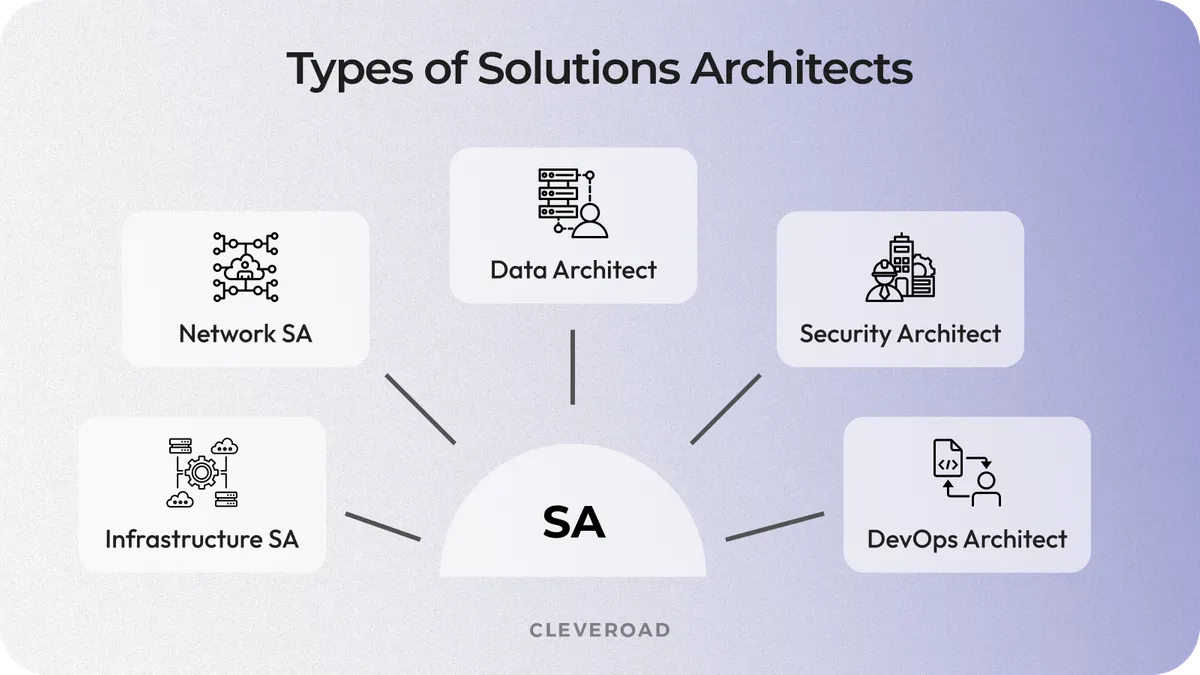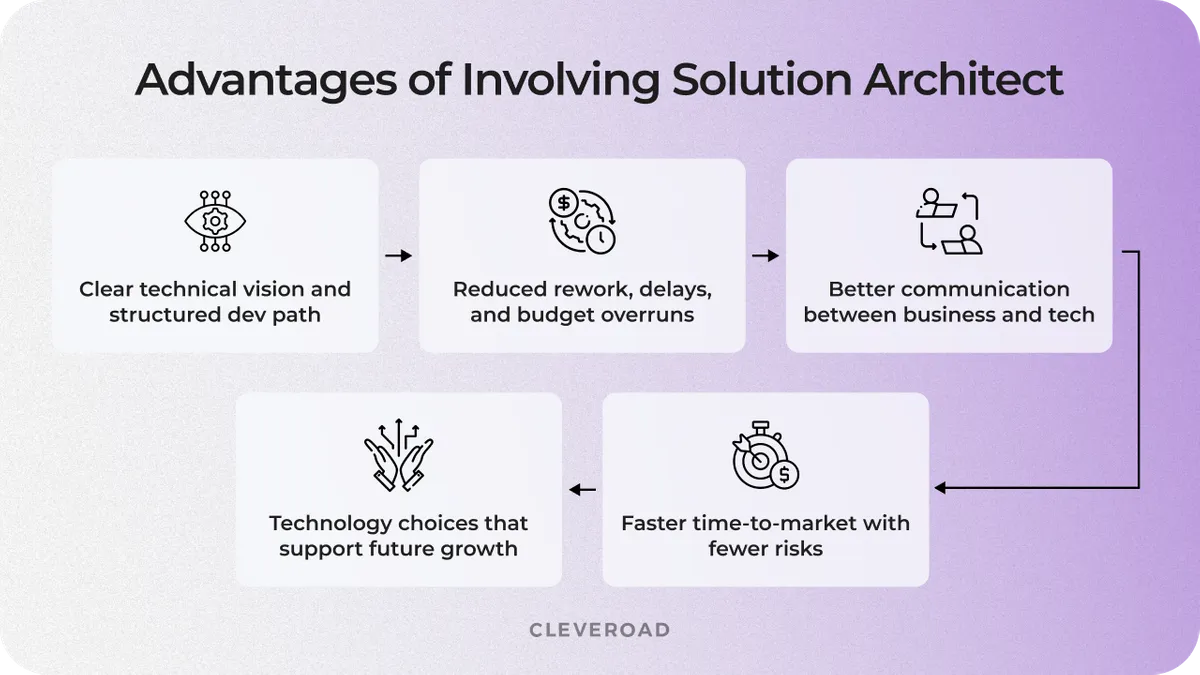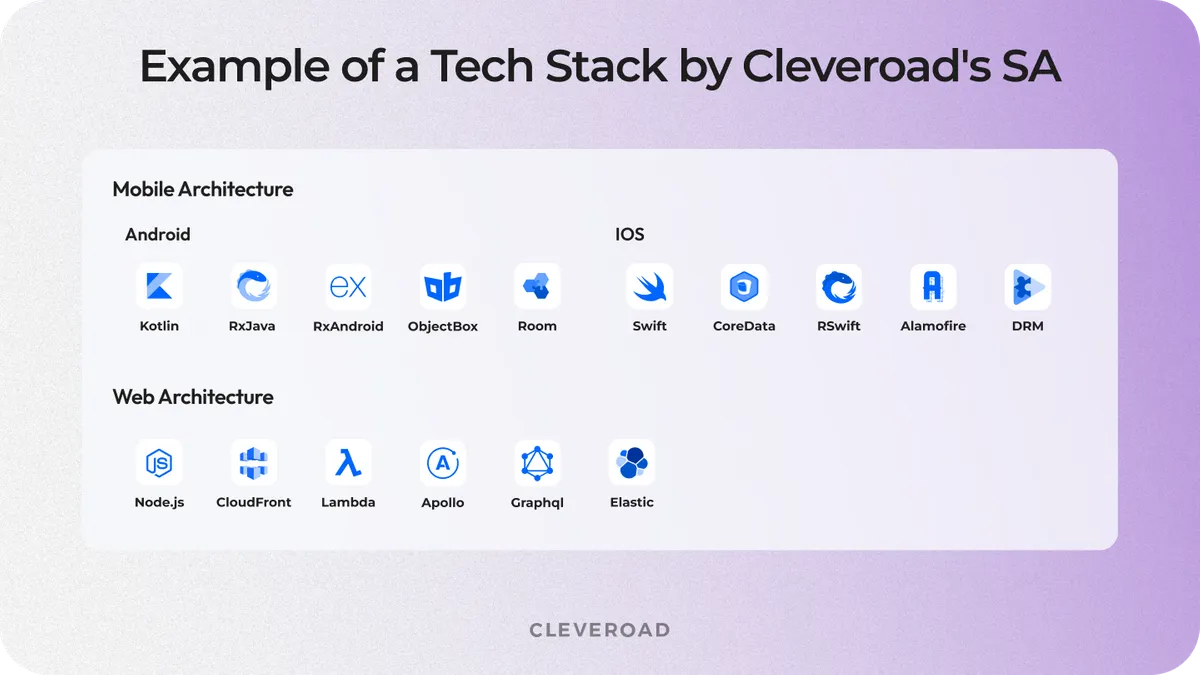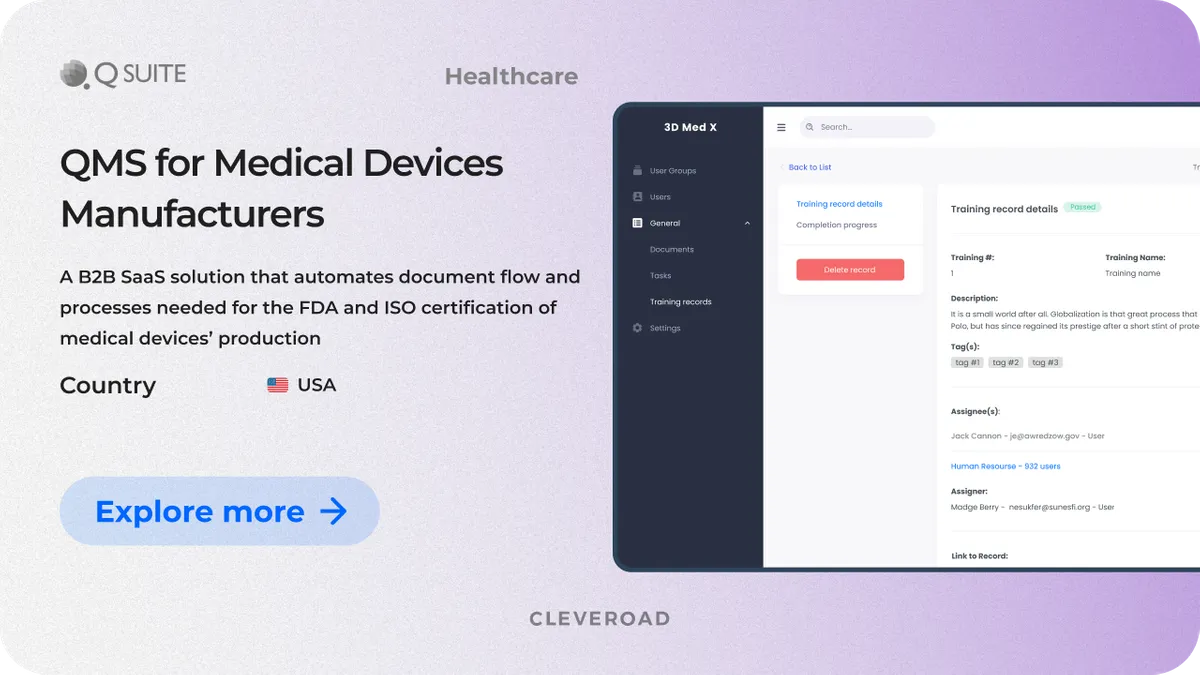What Is a Solutions Architect? Roles, Skills, and Responsibilities
Updated 28 May 2025
18 Min
15509 Views
An IT Solutions Architect (SA) plays a crucial role in any software project, responsible for designing and implementing a technology product tailored to meet your specific business needs or problems. SA professionals have a deep understanding of various technologies and leverage both technical and business expertise, which allows them to align your business software with your strategic goals.
Cleveroad’s certified Solution Architects bring over 10 years of hands-on experience in designing and implementing complex technology solutions. We asked our SA experts to explain the core responsibilities of a solutions architect and clarify how this role differs from others like project managers or developers, and compiled their responses into this comprehensive article. Read on to find out when you actually need their input and get practical tips on what to look for in a qualified specialist and how to evaluate essential skills.
What Is a Solution Architect?
A solution architect is a person who finds the best tech solution to clients’ business problems. The role of solution architect is to provide technical guidance to help clients build solutions that are secure, reliable, cost-optimized, and fault-tolerant. SA specialists bridge business needs and tech that developers should use. Architects speak both ‘technical’ language with developers and ‘business’ language with clients.
For example, a travel provider like Booking.com wants to create an app to let customers book flights, hotels, and cabs from mobile devices. A solution architect's job here is to explain how this app can be built, what tools, such as programming languages, frameworks, and APIs, developers will use, and how much time this process will take.
How a Solution Architect differs from other IT roles
The solution architect roles stand apart from other IT positions by focusing on the big-picture vision and technical strategy of a software product.
Here’s how they differ from other key roles in a development team:
- Project manager. Project managers operate timelines, resources, and communication between stakeholders and the development team, but don’t define how the system will function or scale. The software architect takes ownership of the product architecture that supports project plans.
- Business analyst. A business analyst identifies project stakeholders, gathers their input, and translates business goals into a clear list of requirements. They focus on what the product should do and why. A solution architect takes that input and defines how to build the system.
- A tech lead or senior developer. A tech lead and senior developer focus on building specific solution features or modules within the system. They follow the structure and standards set by the enterprise solution architect, who ensures system-wide consistency and alignment with business goals.
Vadym Khalymendyk
Senior Solution Architect at Cleveroad
“Architecture decisions shape the entire product lifecycle. As solution architects, we don’t just choose tools, we build the foundation for business growth, scalability, and long-term system resilience.”
Types of solutions architects by specialization
Mainly, “solution architect” is a broad term used to define this expert. However, the title can vary depending on the SA's basic scope of activity and specialization. Here are the IT solutions architect types:
Infrastructure Solution Architect. Such experts deal with enterprise IT infrastructure. They’re in charge of creating and implementing the data center infrastructure. This solution architect gathers the business requirements and develops an infrastructure strategy that aligns with the business goals.
Network Solution Architect. A network solution architect’s primary responsibility is to design the computer network. Such architectors should concentrate more on networking areas such as LAN, WAN, internet, intranet, VPN, IDS, IPS, Firewall, etc.
Data Architect. Data architects are mediators between business operations and IT. These architects answer for determining procedures and technologies to be applied in collecting, structuring, storing, and accessing enterprise information.
Security Architect. A security architect is the one who takes care of IT system security and businesses’ mandatory compliance regulations (e.g., SOC2, PCI-DSS, HIPAA). They’re responsible for designing network and computer security and maintaining security controls on the infrastructure, etc.
DevOps Architect. These experts are in demand as Agile SDLC practices and Continuous Integration and Continuous Deployment (CI/CD) get increasingly integrated into the business. They create the CI/CD pipeline not only for the software to be deployed but also for supplying infrastructure.

Types of solutions architects by specialization
Solution Architect Roles and Responsibilities
The role of a solution architect is to design the overall architecture of a software solution and guide its development with a clear strategic focus. They ensure the solution aligns with the existing enterprise systems from technical, business, and user perspectives. SA must understand how the client's product and service fit into the architecture to ensure its successful delivery.
Now, let’s look at the responsibilities an IT solution architect has on this road.
Conduct an architectural system evaluation
Before embarking on product deployment, the solution architect role is to analyze your company's IT landscape to map business expectations with current IT capabilities. This information will allow SA to determine whether the software you plan to develop will fit the existing enterprise environment.
Cleveroad's solution architects always start with a deep audit of our client’s systems. We examine infrastructure, tools, workflows, and tech gaps to build a product that integrates seamlessly with the current tech architecture.
For example, our solution’s architects were engaged in collaboration with our client from the USA, a logistics provider, Unified Potential. Our customer needed to build a P2P ridesharing solution that connects drivers with riders throughout the area and helps transport those who are disabled or have other medical needs. During this project, our IT solutions architects developed a technical implementation plan for the client's idea, enabling the necessary functionality. Such an approach saved both time and budget and kept the rollout aligned with long-term goals, thanks to choosing the right tech stack and integration road from the start.


Meeting functional requirements
Any requirement that specifies what software should do is a functional requirement. For example:
- Users can not use the website if there is no internet connection
- The mobile app should have some function in an offline situation
- When a new user signs up, an email is sent to their email address
Among the responsibilities of solution architects is making sure the software they work on meets all functional requirements. At Cleveroad, our specialists provide product quality assurance and control at all levels to validate every part of your software, and multi-level technical support options.
Meeting non-functional requirements
There are also non-functional requirements that refer to how the software performs a certain action. For example, you want the team to create an admin panel and let your employees log in. Are you okay with a login that takes 20 minutes? We suppose that you’re not. It's a solution architect’s responsibility to prevent this scenario by defining performance benchmarks and system constraints from the start.
Examples of non-functional requirements:
- Use English, German, and Italian localization; default language — English
- The mobile app must support portrait mode only.
- The application supports native fonts only
Cleveroad’s solution architects successfully satisfy non-functional requirements by designing a system architecture that ensures performance, scalability, and reliability from the start. They define key benchmarks during the Discovery Phase, select technologies that can handle real-world loads, and structure the system to support fast response times, stable operation, and seamless user experiences. By embedding these requirements into the architecture early, they reduce rework and ensure the final product meets both technical standards and user expectations.
Decide on a technology stack
The tech architecture strategy directly depends on the technology stack the architects choose. There are many different programming languages, frameworks, libraries, databases, architectural patterns, and standards. The responsibility of a solution architect is to pick the most suitable tools for a particular project, which requires decent tech skills to assess and compare tools.
Cleveroad solution architects are experienced in providing a tech stack that is tailored to our clients' business opportunities and needs. Let’s see an example of the technology stack our solution architect suggested when we we’re developing a video-on-demand platform, called Blockbuster:
Deal with project constraints
Every project comes with constraints, such as tight deadlines, fixed budgets, limited tech resources, or strict compliance requirements. The solution architect responsibilities involve identifying these limitations early and designing a system that can be developed to meet them all without compromising performance or scalability.
At Cleveroad, our software solution architect team handles project constraints with precision. Whether clients need HIPAA-compliant software development, a cost-efficient logistics tracking platform, or a scalable FinTech solution with real-time processing, we tailor the architecture to meet the challenge. We use proven methods to balance trade-offs between speed, cost, and functionality while keeping the long-term product vision intact.
Need an experienced solution architect for your software project? Opt for our IT staff augmentation services to hire an experienced SA who will align your product vision with a robust technical implementation
Solution Architect Technical Skills, Experience, and Background
A good solution architect acts as both a strategist and a technician, bridging the gap between stakeholders and engineering teams. Below, we break down the essential skills and competencies that define a qualified software solution architect.
Experience in software engineering and architecture
Every solution architect must start with a solid background in software engineering. It gives them the foundation to understand how different systems interact and how to design a scalable, maintainable enterprise architecture. This combination of real-world experience and architectural thinking equips them to make sound decisions from the very first project phase.
Practical experience in your domain
Technical skills alone aren’t enough. A solution architect profile becomes truly effective when matched with experience in a specific business sector. Whether it’s DORA implementation for FinTech in the EU or protection of sensitive patient data for Healthcare, industry-specific knowledge allows the technical architect to design systems that reflect real-world needs.
Knowledge of cloud computing platforms
Cloud expertise is mandatory for solution architects. Architects must know how to use platforms like AWS, Microsoft Azure, and Google Cloud. It helps them build scalable, resilient, and cost-efficient systems. These platforms offer a broad set of services, and solution architects must select the right tools for compute, storage, networking, and security.
We at Cleveroad possess a high level of expertise and proficiency in providing cloud services, assured by receiving Amazon Web Services (AWS) Select Tier Partner status within the AWS Partner Network.
Understanding of integration patterns
The role of a solution architect also includes connecting new software to legacy systems, CRMs, payment providers, and third-party APIs. That’s why an enterprise architect must understand typical integration patterns and how to apply them effectively. They also ensure that all integrations align with the product’s scalability and security goals.
For example, in Healthcare solutions, Cleveroad’s SA provide HL7 integration to enable secure data exchange between EHR systems and the newly built platform, ensuring compliance with healthcare regulations and real-time interoperability. In eCommerce projects, they use REST APIs to synchronize order data with external payment providers or CRM systems, such as Salesforce, while designing the architecture to maintain performance and protect sensitive information under heavy loads.
Familiarity with computer networks and security
Security and infrastructure go hand-in-hand. An effective solution architecture role requires a firm grasp of computer networking, data protection, and IT security management. Whether they design a telemedicine app or a FinTech backend, architects implement secure authentication, encryption standards, and compliance features from day one. Their decisions protect user data and ensure systems meet various industry regulations.
Cleveroad employs various methods to ensure robust data security, including:
- Security testing
- Malware & fraud protection
- Vulnerability assessment
- Encryption libraries
- RegTech
- Role-Based Access Control (RBAC)
Since Cleveroad is an ISO-certified company upholding ISO 27001:2013 for security management and ISO 9001:2015 for quality management systems, our solution architects understand how to build software that complies with rigorous quality and security standards.
Certifications to validate expertise
Professional architect certification confirms a candidate’s readiness for the solution architect role and responsibilities. Some of the most authoritative SA certifications include:
- AWS Certified Solutions Architect
- Microsoft Azure Architect
- Google Professional Cloud Architect
- Axelos ITIL Master Certification
These credentials prove that the architect understands both current technologies and the business outcomes they must support.
Cleveroad has AWS Certified Solutions Architects who design cloud architectures that are secure, scalable, and cost-efficient
Business analysis and systems thinking
Beyond technical design, solution architects must understand business processes and how software can support them. They translate complex requirements into practical designs and spot inefficiencies before solution development starts. This strategic mindset is a core part of solution architect responsibilities. It’s what lets them propose not just a working product, but a product that adds measurable business value.
Communication and leadership skills
A solution architect job description includes more than architecture diagrams. Architects must lead discussions with executives, guide developers, and explain trade-offs in plain terms (Source: Solutions Architect's Handbook). Strong interpersonal communication and negotiation skills allow them to align business and tech teams toward a single goal.
When Do Companies Need a Solution Architect?
A solution architect helps companies turn complex business goals into structured, scalable software systems that align with technical and strategic needs. Let’s take a closer look at the cases when you need an IT solution architect for your project.
Complex software projects with multiple systems
When your software must connect to several services, databases, or third-party platforms, it leads to high complexity. For example, if you want to develop a telemedicine system and integrate it with EHR, CRM, lab systems, and implement 3-rd party integrations for payment processing, you'll definitely need an SA to carefully plan your new software architecture and ensure seamless interoperability.
An IT solution architect ensures all systems communicate effectively, data flows correctly, and security stays intact across the infrastructure. Without this role, teams may create isolated modules that fail to integrate or scale. If your product spans mobile apps, web dashboards, admin panels, and legacy systems, you need someone who sees the full technical picture and ensures cohesion.
We've explained how to create tech startup business plan to take your idea in the right implementation direction
Cleveroad solution architects have in-depth experience in managing complex software projects. To demonstrate this, let us show our recent case study.
We’ve provided dedicated development team services to our client from the USA, a leading event production and event technology services company, called AVFX. They deliver the technical backbone for impactful meetings, inspiring events, and engaging trade shows. AVFX supports events for local companies and major brands alike, including industry leaders like Philips, HomeGoods, and Medtronic.
AVFX needed a custom presentation management system to replace their outdated in-house solution. With operations across multiple event venues, they demanded a flexible and scalable system to streamline presentation workflows, both online and on-site.
Cleveroad’s solution architect led the Discovery Phase, designed the system architecture, and proposed a unified tech stack using JavaScript, React.js, Electron, and AWS. Our specialists defined team composition, created all technical documentation, and ensured the system could scale, remain maintainable, and work offline. AVFX was very satisfied with the work of our SA on their project.
As a result, our customer got a tailored and robust solution that includes an Online Web Portal and an On-Premise App Suite. The platform powers events with 75+ workstations and supports future scaling to 200+. We continue our partnership to provide expert support and product optimization.
Here’s what AVFX leaders say about collaboration with Cleveroad:
AVFX & Cleveroad: A Successful Technology Partnership - Client Testimonial
Digital transformation or modernization initiatives
Businesses are constantly upgrading their legacy systems to meet modern trends and scale their needs, often choosing cloud platforms. Such an approach involves architectural changes, data migration, and integration with other business systems. A software solution architect evaluates what to keep, what to replace, and how to transition without disruption in workflows. Their strategic input reduces downtime and helps you adopt the right technologies to support future growth.
Need to align IT strategy with business goals
Startups and enterprises often struggle to connect what they want to achieve with what their tech can actually deliver. The solution architect role acts as the bridge between product expectations and the technical team. They turn business objectives into a workable system solution design that guides product development. For example, if your goal is to expand an existing solution or a new solution into new markets, the solutions architect helps ensure your platform supports localization, compliance, and operational scalability.
Risk of project failure due to architectural gaps
Poor system design often leads to missed deadlines, cost overruns, or unstable software. Without an experienced IT solution architect, teams may discover critical problems too late, when the fixes are most costly. SA expert identifies architectural risks early, defines clear development paths, such as selecting the right system structure, data flow, and integration methods. Also, they provide a detailed architecture roadmap that outlines how components interact, what technologies to use, and who is responsible for each part, which reduces miscommunication. (Source: ACM Digital Library). If your past projects suffered from rework or tech debt, a solution architect can prevent that from happening again.
Projects requiring high scalability or long-term sustainability
Products that aim to serve thousands or millions of users must scale seamlessly. A solution architect designs systems that handle high loads, maintain performance, and evolve over time. Whether you plan to add new features, integrate AI, or expand globally, this role ensures your foundation supports future goals. For long-term product health, the solution architect roles and responsibilities go far beyond launch, they shape your ability to grow without breaking the system.
If you're unsure whether your project requires a Solution Architect, we’re here to help. Our Dedicated Development Team services focus on assembling a team that aligns precisely with your project goals. Feel free to book a strategic call with our experts, and we’ll analyze your requirements and suggest a team composition tailored to your product’s technical needs and budget constraints.
Strategic Advantages of Involving a Solution Architect
Bringing an IT solution architect into your software project early gives your business a competitive edge. This role extends beyond system design, helping shape product direction, mitigate risks, and align technical execution with strategic goals. Let’s break down the core advantages of involving a solution architect in your project.

Advantages of involving a Solution Architect
Clear system structure and aligned execution
A solution architect role is to translate business goals into a complete system blueprint. They define how each part of the software should interact, from backend workflows to frontend behavior, and coordinate that structure across teams. This alignment helps avoid fragmented development, ensures everyone works toward the same outcome, and speeds up delivery with fewer blockers along the way.
Reduced rework, delays, and budget overruns
Many software projects fail due to poor upfront planning and vague technical direction. A solution architect responsibilities involve preventing these problems by identifying risks early and aligning each feature with your long-term goals. They detect gaps, prioritize work, and avoid unnecessary changes later. That means fewer delays, fewer rebuilds, and a higher chance of staying on budget, especially in projects with tight deadlines or evolving scopes.
Better communication between business and tech teams
Solution architects act as interpreters between business leaders and developers. They understand the business logic behind your product, and they know how to translate it into technical tasks. This alignment ensures that development meets expectations and that key decisions reflect both strategy and feasibility. With a solution architect in place, your product development team, engineers, and stakeholders work with shared context.
At Cleveroad, our Solution Architects actively participate in planning and review meetings when strategic or technically complex changes are involved. They help bridge the gap between business objectives and technical execution by translating new requirements into clear technical tasks for the development team.
Technology choices that support future growth
The wrong tech stack can block you from scaling later. Solution architect tasks include helping avoid this by selecting tools and frameworks that support performance, security, and integration. They also design for adaptability, so you can expand features or handle more users without the need to rework the system. Whether you are building an MVP or planning a global launch, your choices shape your product’s ability to evolve.
Faster time-to-market with fewer risks
When software architecture is solid from the beginning, development moves faster and more smoothly. Teams can work in parallel, features integrate cleanly, and testing cycles shorten. An SA helps reduce blockers, make decisions faster, and deliver the first product version without unnecessary detours. That means your business gets to market sooner, with a product that is ready to grow.
All these benefits are guaranteed by working with a qualified solution architect who has extensive experience in software development and understands the intricacies of your industry.
How Cleveroad's Solution Architects Can Help You
Cleveroad is a professional software development company with over 13 years of experience in the IT market. We are headquartered in Estonia, the Central and Eastern Europe region, but have R&D centers in Estonia, Poland, Ukraine, the US, and Norway. Cleveroad helps startups, small to medium-sized businesses (SMBs), and enterprises deliver custom digital solutions that enhance their performance and customer experience.
Our IT solution architects have hands-on experience in multiple industries, including Logistics, Healthcare, Retail, Education, FinTech, and various other business domains. They also design and deploy cloud architectures on AWS and other platforms, ensuring high availability, scalability, and cost-efficiency from day one. With deep knowledge of cloud-native patterns and services, they tailor infrastructure that meets specific business and technical needs. Our specialists combine expertise in both traditional and emerging technologies, such as big data, blockchain, Machine Learning, and Artificial Intelligence (ML&AI).
- ! To demonstrate the high-level competency of our Solution Architects, let us present Cleveroad's latest case with our SA participation: a Quality Management System (QMS) for Healthcare.
Our client is a Prime Path Medtech company from the USA that helps small and mid-sized medical device manufacturers bring their products to market across U.S. region and globally. They support clients in navigating regulatory, clinical, and quality challenges, with a strong focus on proper documentation. As their client base expanded, they needed an affordable, user-friendly document management system tailored to smaller companies. Their outdated solution could no longer support growing demands. To enhance user experience and boost revenue, they turned to Cleveroad to develop a new quality management system with a reliable backend that ensured compliance and scalability.
To solve customer’s business challenges, we’ve assembled a team of 9 experts, including a Solution Architect with deep expertise in IT structure management and software development. Our team has conducted an in-depth analysis and built a SaaS-based architecture, initiating automation and switching to electronic document management, complying with FDA and ISO requirements.
Our SA designed the solution architecture to consider all business requirements. We’ve implemented a role-based access control (RBAC) with three different roles to enable access level management. Via settings on the User group level, our client can configure users' permissions. Our development team has also implemented core logical modules and features pre-defined by the Solution Architect.
As a result, our client has received a responsive and user-friendly web-based QMS and has easily integrated it into our customer’s services. In addition, the new QMS allowed them to digitize and make processes transparent, with improved usability for all parties.
Look what Breanne Butler, CLO at Prime Path Medtech, says about cooperation with Cleveroad:
Breanne Butler, Client Liaison Officer at Prime Path Medtech™
A solution architect is a person who finds the best tech solution to clients’ business problems. The role of a solution architect is to provide technical and non-technical guidance to help clients build a solution application architecture that is secure, reliable, cost-optimized, and fault-tolerant.
Solution architect bridges business requirements and tech means developers need to use to meet these requirements. Architects speak both ‘technical’ language with developers and ‘business’ language with clients.
A solution architect is responsible for:
- Conduct an architectural system evaluation
- Meeting functional requirements
- Meeting non-functional requirements
- Decide on a technology stack
- Deal with project management constraints
The solution architect’s role stands apart from other IT positions by focusing on the big-picture vision and technology architecture of a software product. A solutions architect professional builds a clear tech vision for a solution that shows how the future product will meet the requirements of non-technical stakeholders. Then, they pass this vision to the development team and support them through the entire implementation phase.
To find a qualified solution architect, look for proven experience in your industry, strong technical and business skills, and relevant certifications. Check their past projects and how their solutions align with business goals of their clients. For complex solutions, consider trusted vendors like Cleveroad that offer certified architects as part of their development team.

Evgeniy Altynpara is a CTO and member of the Forbes Councils’ community of tech professionals. He is an expert in software development and technological entrepreneurship and has 10+years of experience in digital transformation consulting in Healthcare, FinTech, Supply Chain and Logistics
Give us your impressions about this article
Give us your impressions about this article
Comments
5 commentsGreat piece of writing with immensely informative contents! I really liked the writing style and the whole process of the story building. Waiting for more posts! Cheers!!
Thanks for topic contents
A really good overview about the role which I was looking for
Got a brief idea about Solution Architect. Thanks.
Thanks for your information
Thank you for your information.


